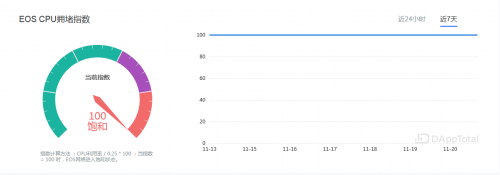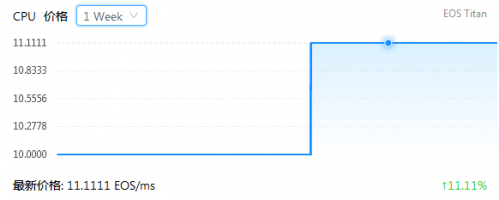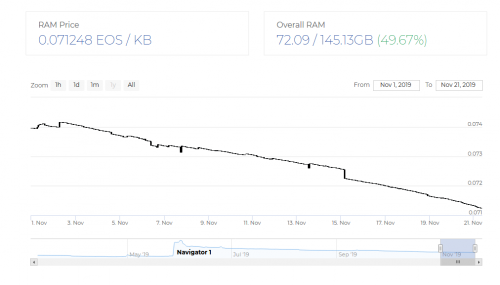EOS CPU congestion index reaches 100%, only 13% of available CPU
Source: Financial Network · Chain Finance
Author: LornaQ
At present, the EOS CPU congestion index reaches 100%, the EOS network has entered saturation and the congestion has been going on for nearly three weeks. 87% of the CPUs are in an occupied state, and only 13% of the available CPUs are available. According to the IMEOS report, as of November 19, the total CPU consumption of the entire network was 11,353,236ms, which caused the DApp EIDOS of the EOS network to consume 82.93% of the entire network.

- just! "The first block of the blockchain" Jianan Technology listed, 26 questions responded to everything | Ling listen exclusive
- A picture to understand the gap between the rich and the poor in the "BTC World"
- "The first share of the mining machine" Jianan Technology's listing "core" journey
EOS CPU
The price of the EOS CPU increased by 11.11% in 7 days, from 10EOS/ms to 11.11EOS/ms.

CPU
The popularity of EIDOS has gradually declined. According to DApp Total data, the number of EIDOS 24-hour active users has decreased by 42.28%, and the 24-hour transaction volume has decreased by 56.5%.

EIDOS
On November 1st, EIDOS tokens were airdropped on EOS to attract a large number of wool parties. The peak number of active users of the DApp reached 4,730, which is currently down to 1,580. It is reported that the airdrop will last for 15 months. As far as the current situation is concerned, the EOS network will remain congested. Most EOS users are still in a state where they are unable to trade, and need to use a third-party account to help with the mortgage, to suspend the status of the account "catch".
Previously, the financial network-chain financial mentioned that the EOS system mainly contains three kinds of resources, namely network bandwidth resources (NET), CPU computing resources (CPU), and running memory resources (RAM). Among them, the CPU is one of the resources consumed by the user when making a transfer or transaction. The network bandwidth resource (NET) is used to synchronize and transmit a transaction. When the user sends a transaction message, the block producer needs to package the transaction to generate a block, and then synchronize the block to other producers through the network. This process requires a certain amount of NET. Running memory resources (RAM) is used to record and store information, including user account information and smart contract execution information.
According to EOS Titan data, after the launch of the EIDOS airdrop on November 1, the CPU cost is 0.41ms/EOS, and the CPU cost is 0.1ms/EOS from November 7th to November 18th. The current cost price is 0.09ms/EOS. . In the EOS network, when the number of EOSs used to exchange CPU resources suddenly increases, the available CPU resources corresponding to one EOS are reduced. CPU usage fluctuates between 20% and 36%.

CPU cost price
According to EOSPark data, EOS has allocated 49.67% of memory, or 72.09GB (total supply is 145.13GB), and has used 7.06% of memory. The effective usage rate is 14.22%. The price of RAM continues to decrease, and the current price is 0.071248 EOS/KB.

RAM
According to EOS Titan data, the cost price of NET continues to fall. The cost of NET on November 1 is 0.73MB/EOS, and the cost of NET on November 21 is 0.83ms/EOS.

NET
According to CoinmarketCap data, EOS is currently priced at $3, and on November 1, the price was $3.25, a 24-hour drop of nearly 4%, and a market capitalization of about $2 billion.

EOS
We will continue to update Blocking; if you have any questions or suggestions, please contact us!
Was this article helpful?
93 out of 132 found this helpful
Related articles
- Hangzhou launched “government service chain” “One main multi-side” technical structure to meet government needs
- Why is the project of Stanford University becoming more and more in China?
- Behind the "per-billion dollar bitcoin permanent loss": Bitcoin almost died
- Viewpoint | Checking the block Nonce distribution to track changes in mining equipment
- The patron saint of DeFi: talk about the new "insurance" track
- Introduction to Blockchain | Valuation Models for Blockchain Industry and Its Disadvantages
- QKL123 Quote Analysis | What is Bitcoin? Can be compared to gold (1121)






